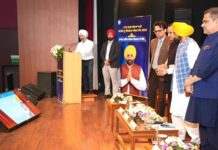The pro- environment organisations Warrior Moms, Earth Warriors and The Sikh Forum, have written to Punjab chief minister Bhagwant Mann drawing his attention about two critical environmental issues facing the state; the alarming depletion of groundwater in Punjab and persistent pollution of the Buddha Dariya.
These issues demand urgent and decisive action to safeguard Punjab’ health, environment, and agricultural sustainability, stated Bhavreen Kandhari from Warrior Moms, Pankaj Kumar from Earth Warriors and Ravinder Ahuja from ‘The Sikh Forum’.
Groundwater Depletion: An imminent threat in addition to the dire situation with Budda Dariya, we also wish to draw your attention to the critical issue of groundwater depletion in Punjab. Recent data indicates that the groundwater table in Punjab is declining at an alarming rate of 0.49 meters annually.
Out of Punjab’s 153 blocks, 117 are classified as over-exploited, 3 as critical, 13 as semi-critical, and only 20 remain in the safe category. This situation poses a severe threat to the sustainability of our agriculture and the overall well-being of our population.
Punjab Agricultural University attributes this crisis to factors such as the lack of systematic groundwater extraction planning, shifts in cropping patterns, the proliferation of tubewells, a decline in canal-irrigated areas, and decreased average annual rainfall.
The Central Ground Water Board (CGWB) reports a groundwater recharge rate of 18.84 billion cubic meters (BCM) against a gross withdrawal of 27.80 BCM, indicating a severe imbalance that could lead to groundwater depletion up to 300 meters deep, creating desert-like conditions in Punjab within 25 years.
Recommended strategies for addressing groundwater depletion: Delaying paddy transplantation can reduce the decline of the water table by 1.5 cm annually. Implementing drip irrigation and other water-saving technologies can significantly reduce water use. Renovating village ponds can help recharge groundwater by approximately 6 cm annually.
Increasing Dyke Heights in paddy fields could save 3 cm of irrigation water annually, reducing groundwater decline by 9 cm per year.
Techniques like laser land leveling and optimized plot sizes can reduce water use in rice and wheat cultivation. Developing underground pipeline systems can reduce conveyance losses by up to 35% compared to traditional earthen channels.
Encouraging furrow irrigation in row crops can save 20-25% of water compared to conventional practices.
Policy Interventions: Shifting from the paddy-wheat monoculture to more diverse cropping patterns can help achieve sustainable agriculture. Enhancing canal infrastructure can improve groundwater recharge and reduce reliance on tubewells.
Lining water courses and promoting underground pipeline systems can minimise water loss. Utilising treated urban wastewater for irrigation can reduce groundwater extraction.
Implementing rainwater harvesting and stormwater management techniques can enhance groundwater recharge.
It is needed to bring together all stakeholders and prioritise the strategies to secure the water resources and protect the health and livelihoods of the people of Punjab. Immediate action on these fronts is not just necessary but imperative to avoid a future where environment, agriculture, and health are irreversibly damaged, they stated.
Buddha Dariya Pollution: A growing crisis despite 28 years of ongoing efforts and the expenditure of crores, the Buddha Dariya, also known as Buddha Nullah, remains a heavily polluted waterway, posing significant health risks and environmental concerns.
The drain, filled with foul-smelling, black water, continues to contaminate the Satluj River, a crucial source of irrigation for Punjab. Numerous initiatives, including the installation of sewage treatment plants (STPs) and bio-remediation projects, have been attempted, yet the situation has only worsened due to mismanagement, inadequate funding, and bureaucratic delays.
The latest Buddha Dariya Rejuvenation Project, launched in 2020 with a budget of Rs 519 crore, faces significant setbacks, including unresolved land disputes and non-functional effluent treatment plants.
The gravity of the situation becomes even more alarming when we consider the latest report published by the Punjab Pollution Control Board in May 2024.
Before the Satluj River meets the Buddha Dariya, its dissolved oxygen levels are above 8 mg per liter, with a Biochemical Oxygen Demand (BOD) of 1.3 mg per liter, and fecal coliform bacteria levels around 1,100 MPN.
However, just 100 meters downstream from where the Buddha Dariya merges with the Satluj, the oxygen levels drop to zero, and the fecal coliform count skyrockets to an alarming 1.7 million MPN per 100 ml.
This stark degradation underscores the Buddha Dariya’s severe pollution, which not only threatens the Satluj River but also has far-reaching consequences for the health of communities downstream.
Recent reports, including one from Down To Earth, highlight a disturbing rise in cancer cases in villages along the Satluj, directly linked to this contamination.
To address this urgent issue, it is imperative to prioritise the clean-up of the Buddha Dariya, ensuring that all STPs and Common Effluent Treatment Plants (CETPs) along its course are fully functional and properly maintained.
Resolve land disputes and remove all bureaucratic roadblocks hindering the Buddha Dariya Rejuvenation Project. Implement strict monitoring and enforcement of environmental regulations to prevent further pollution of the Buddha Dariya.
Review and optimise the operational efficiency of existing treatment infrastructure, ensuring that the effluents being discharged meet the required standards.




